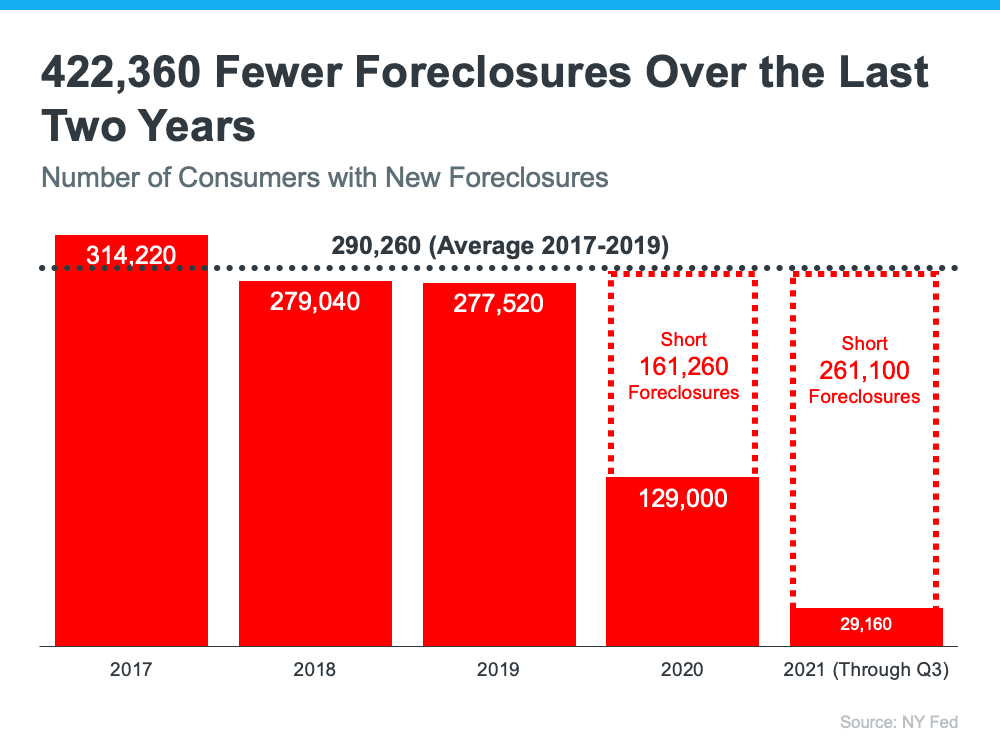The below post is a transcription from one of our recent videos. We have added additional information about the topic as well as additional graphics and resources. We hope you find this information helpful, and if there is a real estate topic you would like us to cover, please reach out! We love helping provide Real Estate information for the Denver metro area, which helps our real estate clients and anyone who could use the help.
In early 2020, when mortgage forbearance plans were announced and the pandemic swept across the country, many homeowners were told to pause their mortgage payments. Analysts were worried that the housing market would suffer a wave of foreclosures in the wake of the forbearance program ending as it did after the housing bubble 15 years ago.
The following explains why that’s not the case.
1. There Are Fewer Homeowners in Trouble This Time
Over nine million households lost their homes during the last housing crash through foreclosure, short sale, or by giving them back to the bank. Some believed the same would happen this time around.
Today’s data shows that most homeowners have either caught up on their payments or were able to restructure their loan so they can begin making payments again after the forbearance period. A new study by the Mortgage Bankers Association (MBA) examines how many people left the forbearance program between June 2020 and November 2021.
Here are those findings:
38.6% left the program paid in full
- During the forbearance period, 19.9% of the borrowers made their monthly payments
- 11.8% made up all past-due payments
- 6.9% of borrowers paid off their loans in full
44% negotiated work-out repayment plans
- 29.1% of loans were deferred
- 14.1% of borrowers received a loan modification
- 0.8 percent arranged a different plan for repayment
0.6% sold as a short sale or did a deed-in-lieu
16.8% of the participants left the program with no loss mitigation plan in place
2. Those Left in the Program Can Still Negotiate a Repayment Plan
In the week ended last Friday, 890,000 mortgages were still under forbearance. A customer who is still in forbearance still has the option of working out an agreement with the servicing company that represents their lender. Federal and state agencies are pushing servicing companies to do just that.
RealtyTrac’s CEO, Rick Sharga, said this recently in a tweet:
“The [Consumer Financial Protection Bureau] and state [Attorneys General] look like they’re adopting a ‘zero tolerance’ approach to mortgage servicing enforcement. Likely that this will limit #foreclosure activity for a good part of 2022, while servicers explore all possible loss [mitigation] options.”
Check out the warning issued by the New York State Attorney General for more information.
3. The majority of homeowners have sufficient equity to sell their homes
In the event that a solution cannot be negotiated and the 16.8% left the forbearance program without a work-out, many will have enough equity to sell their homes and avoid foreclosure.
Since home prices have been rising rapidly over the past two years, the average homeowner has gained record amounts of equity in their home. CoreLogic CEO Frank Martell explains:
“Not only have equity gains helped homeowners more seamlessly transition out of forbearance and avoid a distressed sale, but they’ve also enabled many to continue building their wealth.”
4. Foreclosures have decreased dramatically over the past two years
In addition to being seldom reported, the forbearance program allowed households experiencing financial difficulties before the pandemic to participate. It gave those homeowners an extra two years to get their finances in order and work out a plan with their lender. The new forbearance program prevented over 400,000 foreclosures that would have occurred otherwise. Otherwise, the real estate market would have had to bear the brunt of these foreclosures. This graph shows the data:

5. The current market can easily absorb more than one million new listings
In 2008, foreclosures added to an already overcrowded market of houses for sale. Consequently, there was over nine months’ supply of listings. Anything over six months’ supply can cause prices to decrease.
It’s exactly the opposite today. Based on the current Existing Home Sales Report published by the National Association of Realtors (NAR):
“Total housing inventory at the end of November amounted to 1.11 million units, down 9.8% from October and down 13.3% from one year ago (1.28 million). Unsold inventory sits at a 2.1-month supply at the current sales pace, a decline from both the prior month and from one year ago.”
There should be approximately six months of inventory supply in a balanced market. With 2.1 months, the market is severely understocked. There won’t be enough inventory to meet demand even if one million new homes are added to the market.
Bottom Line
There will be no impact on the housing market when the forbearance plan ends. Sharga puts it this way:
“The fact that foreclosure starts declined despite hundreds of thousands of borrowers exiting the CARES Act mortgage forbearance program over the last few months is very encouraging. It suggests that the ‘forbearance equals foreclosure’ narrative was incorrect. . . .”






